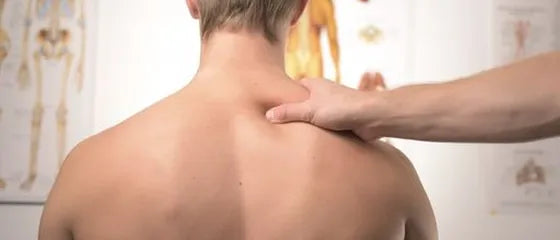-
Former physiotherapist and bartender Malika Saidi on how to prevent bartender injuries
-
3 tips to prevent lower back pain
-
Effective pre- and post-shift exercises and stretches
Being a professional bartender is not for the faint-hearted. The long nightly hours, the lifting of full dishwasher crates and kegs of beer, banging out hundreds of shaken cocktails on a busy night... It takes a serious toll on your body. This is all well and good when you work the occasional shift on a Saturday, but what if it's your fulltime profession? How do you stay fit and healthy behind the bar? Read on to find out how to prevent some common bartender injuries.
After a quick and unscientific research in my bartender network, I have established a top 3 of most common bartender injuries:
-
Lower back pain
-
Shoulder injury
-
Elbow injury
Let's take a closer look at lower back pain and how to prevent it. Lower back pain is one of the most common reasons for people to consult a physician. Most people suffer from non-specific lower back pain, meaning lower back pain with no clear origin.
Common causes of lower back pain
It can be difficult to diagnose the exact causes of lower back pain and the majority of back problems should disappear over time. Some common causes of back problems are: lack of muscle fitness, mostly around the core (your midsection). Bad posture, general lack of movement. Degeneration of the cartilage discs between vertebrae (the bones that make up your spine). Common symptoms include pain across the lower back, often radiating towards the buttocks or legs. Stiffness of the spine, reduced mobility. Muscle spasms or palpable muscle tightness.
How to prevent or treat lower back pain?
Tip 1 - Take a look at your bed
With any injury, prevention is more important than treatment. To prevent lower back injury, it is worth looking at your daily habits and how this could affect your overall health and fitness. Start by taking a critical look at your bed. Is it still comfortable? Does your mattress give you enough support? Too soft or too hard a mattress can have a negative impact on the position of your spine during your sleep. After a long shift behind the bar, a good night's sleep is crucial and will help your body to recover.
Tip 2 - Workout
Next, have a look at your physical activity during the week. Bartending is a physically demanding job, and you'll need to be fit if you'd like to pursue a career behind the bar. For your body to endure the strain of bar shifts, regular exercise is essential. This does not necessarily mean pounding away in the gym 4 times a week, but it is important to do regular exercise. In order to keep this up, you'll need to find something you truly enjoy, or it will be impossible to keep up. Try to make exercise a priority in your week. Think about which habits you can change that will make you more active. For instance, taking the stairs instead of the elevator at any opportunity, walk or cycle to work. Go for a walk during break times. Find a sport you truly enjoy and try to commit yourself to this, 3 times a week. If you find it difficult to physically go to a gym or sports club, there's plenty of exercises you can do in the comfort of your own home. There are numerous free apps that can help to build a regular program, for instance: Nike training club, 7-minute workout, Daily yoga- workout & fitness.
Tip 3 - Focus on your posture
To prevent lower back pain, posture is another factor to consider. As mentioned earlier, your muscles around your core play an important role in preventing back problems. It's important to maintain an active posture during standing, sitting, and most importantly, during lifting. An active posture means no slouching, stomach muscles contracted (pull your belly button inwards), and shoulders slightly back. You can check your standing posture against the wall, feet 10 cm from the wall, your butt, shoulders, and head should be touching the wall. During sitting, don't cross your legs, keep both feet on the floor and alternate positions. Remember to change position (standing, walking, etc.) at least every 30 minutes and make sure you wear proper footwear that supports your posture.
Lifting puts a high strain on your back and should be done with care. To avoid unnecessary stress on your back, remember these basic rules: avoid twisting your back whilst lifting, keep objects as close to you as possible, use large muscle groups in your legs for lifting. If it's heavy, don't be too stubborn to ask for help.
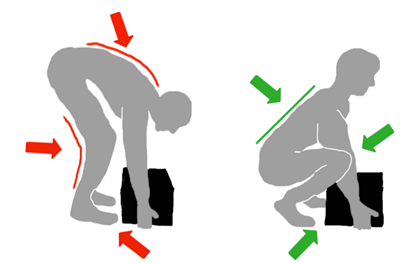
Effective pre- and post-shift exercises and stretches
To prepare your body for a shift or to just stretch it out after, here are some effective pre- and post-shift stretches that may be able to reduce the strain on your back.
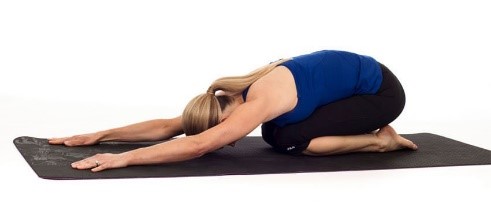
On all fours, place your hands as far away from you and gently lower yourself onto your knees. Repeat 5 times.
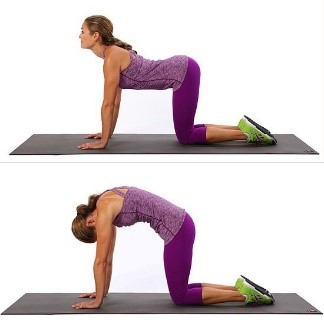
On all fours (hands below your shoulders, knees below your hips) slowly arch your back like a cat, then slowly move your belly button towards the floor. Repeat 15 times
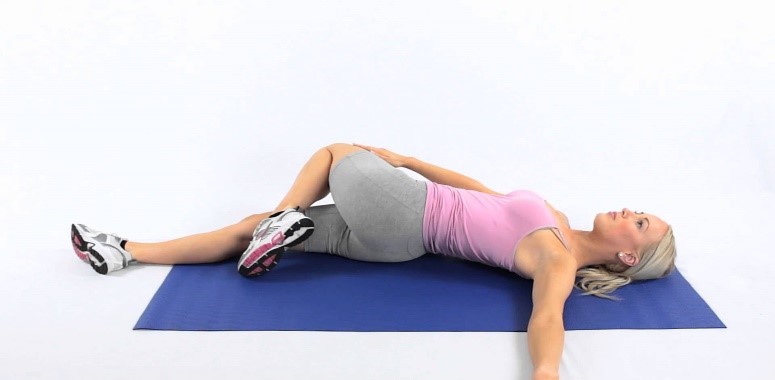
Flat on your back, one knee bent, arms spread out, slowly move your knee to one side. Then slowly move your other knee to the other side, using your stomach muscles. Facing the opposite direction increases the stretch. Repeat 10 times.
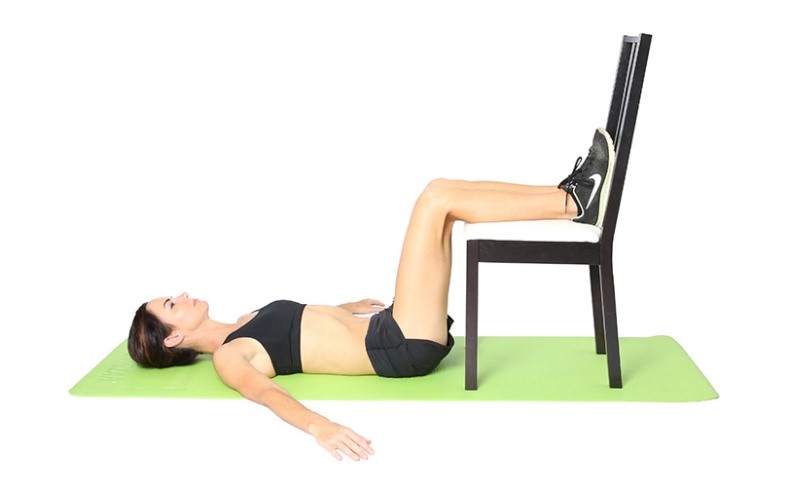
This is a great position to fully relax your lower back after a strenuous shift. After long hours on your feet it's also good to lie on your back as pictured above but then remove the chair and place your feet up on the wall, legs straight. Make sure that your bottom is close to the wall. This is also a good position to drain excess fluid from your legs.
During shift exercises
Taking regular breaks during a busy shift can be challenging, but whenever you have time try to stretch your back, move your shoulders back and remember to maintain an active posture. Find a door and do a doorway stretch: stand facing a doorway, put your hands on the doorframe, shoulders at 90°, elbows at shoulder level. Now slowly take a small step into the door while keeping your arms (relaxed) in place.
Self-diagnosis
Self-diagnosis of any illness can be dangerous, so consult your physician or physiotherapist when you have persistent pain complaints. Remember, when an injury does occur: don't just take time off, change your habits!
Would you like to learn more about injury-free bartending? Then the Advanced Bartending Course is the one for you.

